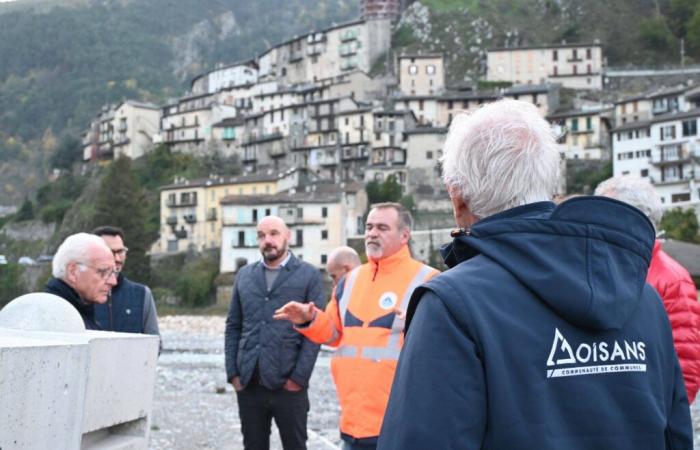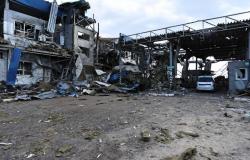Coincidences are sometimes cruel. A delegation of elected officials and technicians from the community of communes of Oisans (Isère), victim of severe bad weather last June, went to the territory of the French Riviera at the very moment when devastating rains fell in Valencia, Spain. While the challenge of the two days of field visits and discussions was precisely to learn the lessons of storm Alex in Roya.
“We want to show you that when we have the communities behind us and everyone gets involved, we can do it, begins the president of Carf, Yves Juhel. But we must have the courage to say to ourselves: we are not going to do the same as before.”
speak with one voice
It is essential that decision-makers speak with one voice. In the case of post-Alex, it was the state services which brought together the active forces. And allowed consistency in the response.
“As of October 14, a dedicated prefect was appointed. He was a privileged contact on each subject. An interministerial mission for the reconstruction of the valleys (Mirv) was also set up”indicates the head of the Gemapi service at Carf, Jean-Christophe Martin. Adding that it is also the State which has carried out more than 2,300 building assessments.
“You need someone like our prefect, he was a real pillar. Otherwise we would have gone in all directions”assures the mayor of Saorge, Brigitte Bresc.
“Our problem is that everything goes through the town hall. No one is seconded to the prefecturebreathes Jean-Louis Arthaud, the mayor of Saint-Christophe-en-Oisans. The Chief of Staff makes himself available but on certain things we have to manage.”
Help the economy
“Thanks to the vigilance of elected officials, we have not had any victimsunderlines the president of the community of communes of Oisans, Guy Verney. But the victims today are economic. In a territory that lives from skiing in winter, and cycling in summer.”
Carf also had to imagine ways to support professionals. A logistics center was thus created for ten months to ensure deliveries to the upper part of the valley.
Of the 1.8 million in direct economic aid given to businesses in Roya, almost a third also comes from Carf.
Juggling with words
“Sometimes, the texts required us to rebuild identically to obtain subsidies. We were unable to obtain certain state funds because we adopted resilience in our operations”asks the general director of technical services, Sylvain Michelet.
Joined by Florent Adamo, geologist at the Department. “Some roads could not be built in the same place. The logic adopted was: what the river took, we leave. We therefore had to do semantic gymnastics to qualify for subsidies.”
Changer l’image
“The objective is that the hamlet of La Bérarde is not remembered as a news item. For our part, the tourist office has worked a lot on this image”explains the general director of Carf services, Valérie Prosellico.
Jean-Louis Arthaud nods. Says that his village has a rich history around mountaineering, and that we will have to build on this image. For the 2025 season, priority will be given to pedestrian access to refuges.
“17 houses will be demolishedadds the elected delegate to Bérarde, Yannick Ducret. But the valley exists, it is not destroyed.”
What dialogue with the population
One of the questions at the heart of the post-disaster debate is certainly the feelings of the population. And on the Carf side, we know how much the destruction of temporary structures could have represented a “blow” in terms of the morale of the inhabitants, already exhausted.
Michel Martin, the deputy mayor of Venosc – a village also very affected by the torrential flood in Isère – is well aware of these realities.
“The Department reconstructed the road in two or three days. But it was a temporary evacuation route, with only a small layer of asphalt. However, people took it for a road. They did not understand not that we can't get tourists through…”, he explains.
Pointing out the importance of communication. “It took pedagogyacquiesce Sylvain Michelet. The inhabitants were touched in their flesh, they needed us to pay attention to them, to give them perspectives.”
As part of the reconstruction, which involved destroying houses, the choice was made to make amicable acquisitions.
“Not everyone played the game, there will be some expropriationsunderlines Jean-Christophe Martin. But we did not want to systematize declarations of public utility. This would have represented a double punishment after the disaster. And we wanted to avoid the land impact: with a DUP, we would have needed a wider area, and therefore taken more plots.”
For his part, Michel Martin advocates a paradigm shift. “Bad habits have been adopted. There have been no more floods of the Vénéon since the 1970s… until we experienced two in one year! People will have to understand that we must change the way we see things and not take refuge behind the work to see the future, we will have to go back, to leave the river alone.
Untenable deadlines
The day after the storm, an inventory was carried out by Gemapi services. “There was limited time to complete the grant applications. We then refined our knowledge of the damage”pose Jean-Christophe Martin.
Works manager at Smiage, Franck Compagnon confirms that the deadline was very short, especially when we know that most of the roads were inaccessible.
“It was very complicated to identify the disorders, to quantify them. Clearly, the emergency procedure of the solidarity fund is not adapted to this type of phenomenon. Three months was not enough.” Especially, he says, that situations were discovered a posteriori.
On the side of the Oisans community, we speak of the same lightning delay: the disaster occurred on June 20; the file was due back on August 15. “The regulations are not appropriate when an entire section of the territory is ransacked”, recognizes Sylvain Michelet.
Despite everything, tips have been found to apply for other aid. “For orphan files which had not been identified under the solidarity fund, we were able to benefit from Steprim – Territorial strategy for the prevention of risks in mountains, says Franck Compagnon. But it must be multi-hazardous.”
Different phenomena
“Storm Alex was a lot of water in a short time: we recorded a cumulative 600mm of rain in Castérino. As for the flow of the Roya, it went from 450 m3/s to 1,400”summarizes Jean-Christophe Martin, evoking an unprecedented scale in France.
“As at La Bérarde, meters and meters of stones were piled up, particularly at Vievola. It was up to eight meters thick”adds the deputy general director of Carf, François Lefebvre.
Jean-Louis Arthaud insists on the fact that in Oisans, the weather phenomenon was not as exceptional: “We had 120-140mm of water… but practically identical consequences. We lost a good part of the building, with rubble transported up to 17m to the village of La Bérarde. As we are facing a very steep slope, the washout is immediate. There was also enormous melting, we lost 1m of snow in 48 hours. This was added to by the draining of a glacial lake. you, 600mm in the valley, nothing would have remained…”






